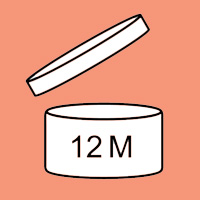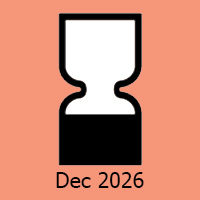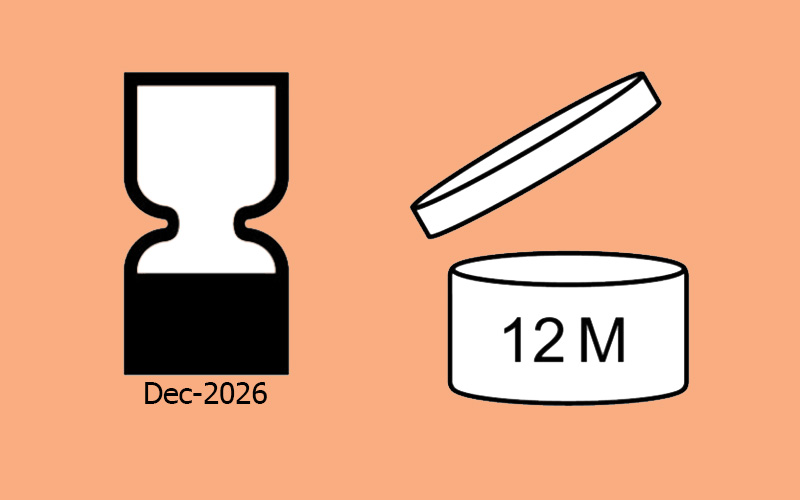In the U.S., it’s common to see the open jar and hourglass symbols on cosmetic and personal care labels. However, they’re often misunderstood, misapplied, or copied without knowing what they actually mean.
That’s because these symbols aren’t regulated or defined in U.S. law. They do, however, have very specific meanings—and required uses—under European Union (EU) regulations. Understanding what they are and how they should be used can help you avoid confusion (and make your labels look more professional and credible).
What the Symbols Mean (in the EU)

Period after opening
The open jar symbol (the “PAO” symbol) shows how long a product remains safe and effective after it’s opened. The number inside or beside the jar (such as “12M”) means 12 months after opening. It’s only used on products that have a shelf life of more than 30 months (2 1/2 years).

Minimum durability
The hourglass symbol shows a “date of minimum durability” — similar to a “best before” or “best if used by” date. The date refers to the time since the date of manufacture, not the date the product is opened. It applies to products that have a shorter shelf life (less than 30 months) before they’re opened. The date must be shown by month and year, or day, month, and year. The symbol may be replaced by the words “Best if used before the end of” followed by the date.
In the EU, the symbols are required:
- If the product’s shelf life is 30 months or less, it must show a “best before end” date, often with the hourglass symbol.
- If the shelf life is more than 30 months, it must show a period after opening (PAO) using the open jar symbol.
- Products that don’t deteriorate after opening (like single-use packets, aerosols, or powders) are exempt.
Usage and Requirements in the US
In the U.S., neither the open jar nor the hourglass symbol is required or defined by regulation. The FDA only requires that cosmetics be safe and properly labeled — there’s no rule on expiration dates, “best before,” or “after opening” indicators.
That’s why many U.S. makers use these symbols incorrectly—or inconsistently.
Common Misuses (and the Correct Information)
1. Using Both Symbols at the Same Time
Misuse:
Some labels show both an expiration date (like “EXP 08/27”) and an open jar (like “12M”). This makes it unclear whether the product expires 12 months after opening or in August 2027—or both.
Correct Use:
- Use the hourglass (and a date) if the product’s total shelf life is 30 months or less.
- Use the open jar (PAO) if it lasts more than 30 months before opening.
You wouldn’t normally use both, unless you’re labeling for multiple markets and clearly explain what each means.
2. Misinterpreting the Open Jar “12M”
Misuse:
Many people (and even makers) think “12M” means “good for 12 months after manufacture.”
Correct Use:
“12M” means 12 months after opening the product — not from when it was made, and not from when it was purchased. It’s intended to show how long the product stays stable after it’s exposed to air or use. In the EU regulations, this symbol is only used when the product is stable when sealed for more than 30 months.
3. Using the Wrong Time Indicator
Misuse:
Using “Y” (for years) in the open jar symbol. For example, using “2 Y” instead of “24 M.”
Correct Use:
The open jar symbol always uses months – even if it is more than a year. “24 M” or “36 M” are both fine.
4. Not Including a Date with the Hourglass Symbol
Misuse:
Using the hourglass symbol but omitting the date by which the product should be used.
Correct Use:
When using the hourglass symbol, the date must be shown. It can be the month and year (“Dec-2026”) or the day, month, and year (“Dec 31, 2026”). Note that under the EU regulations the symbol may be replaced by “Best if used before the end of” followed by the date. In the US, it’s not uncommon to see the symbol replaced similar phrases such as “Best if used by,” “Exp date,” or “expires.”
5. Assigning Random Numbers
Misuse:
Some U.S. makers just pick a number — like “24M” — because it looks official, without any testing or basis for it.
Correct Use:
EU manufacturers are required to justify their stated shelf life or period-after-opening through stability and preservative testing. The PAO is based on actual data showing how long the formula remains stable and safe under normal use conditions.
Even though not required in the U.S., it’s best practice to base any “12M” or “24M” declaration on some form of testing, or leave it off altogether if you can’t substantiate it.
Why This Matters for U.S. Makers
Even though these symbols aren’t regulated here, their use sends a message. They imply the maker understands product stability, safety, and international labeling standards.
Misusing them—or using them in ways that don’t match their accepted legal meaning—can make your products look unprofessional or even misleading to knowledgeable buyers, inspectors, or international retailers.
If you choose to include them:
- Know what they mean.
- Use them correctly.
- Only include information you can back up with real testing or documentation.
Bottom Line
In the U.S., the open jar and hourglass symbols are purely optional—but in the EU, they’re legally defined parts of cosmetic labeling. Understanding how they’re supposed to be used can help you decide whether (and how) to include them on your own labels.
Used correctly, they can add credibility and clarity. Used incorrectly, they just add confusion.


Leave a Reply